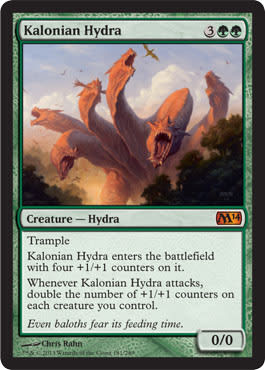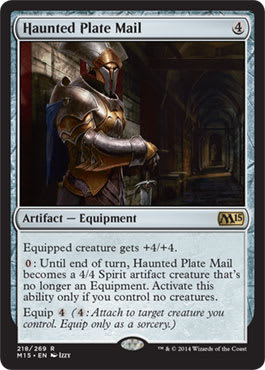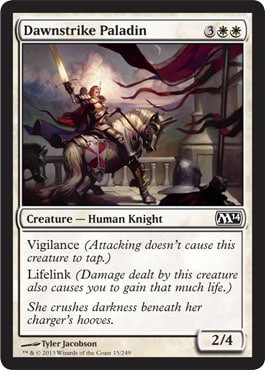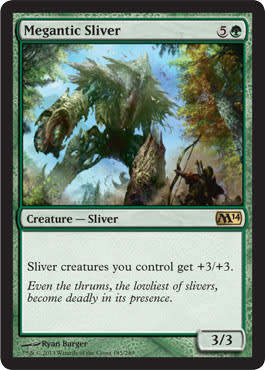This summer, on a whim, I joined my store's five-week Magic 2014 league. I didn't expect much, but it turned out to be fun and unique, and I strongly suggest you try a Theros league when they start up. For being so low-priority for WotC, who appears to leave implementation and promotion to stores, a league is a great experience, if for no other reason than it presents strategic considerations unavailable elsewhere. It's an unusual mix of casual and competitive, the kind of mix that deserves its own article. So, voila—or a non-French equivalent.
What Is a League?
League basics are here. You buy a Sealed pool of six boosters at the beginning, build a forty-card deck, and aim for three matches a week. You can join late and make up matches if you want. My store kept pools in individually-marked boxes so you couldn't fudge with your pool's contents; I assume an equivalent is in place at every store. Keeping the boxes at the store is logistically advantageous; as long as you and somebody else at the store have some downtime—such as between tournament rounds—you can claim your boxes and get a match in. A few players at my store would pop in after work and duel with whoever was there; that flexibility was handy for everyone.
You fill out match slips and standings are kept, but the atmosphere is informal and relaxed. My store put all the participants on an e-mail list so they could schedule matches if they wanted; this appeared to bring in several people whose work schedules don't accommodate evening tournaments. I played against several people on random Monday afternoons; it was nice to have something competitive available for random Monday afternoons.
While this may just seem like a slow-motion prerelease, there's a twist; every week after the first, you can buy another booster pack for your pool. I didn't think through what that would mean when I signed up, but it has major implications on deck-building and strategy. I haven't seen an article yet on league-style Sealed, so here's what I've figured out that might help you win your league.
Living with a Sealed Pool
Have you ever watched a Draft video or stream or attended a prerelease and wondered what it would be like to redo the tournament with a different build or better information on the format? League is a WotC-sponsored way to do that. If you're not sure at the beginning whether you should go W/U or U/B, you can try one pair one week and another pair the second week. The data you gain from the first week can be reliable information for the second week—or at least more reliable than starting decks from scratch every Draft. You form a much better sense of essential Sealed tenets when you're able to play the same people for a while with the same cards.
I can't afford five Sealed tournaments in five weeks, but paying once and messing with a card pool for five weeks gives me the same kind of information. Phantom events on Magic Online can provide you with loads of Sealed experience, and if you made a set-representative Cube, you could do something similar, but for the most part, paper Magic hasn't provided a way to live with your Sealed pool other than joining a league. If you plan to attend a Sealed Grand Prix but aren't made of cash, you might want to try a league to gather a lot of format data in a comparatively short time.
Tweak of the Week
I joined the league in the second week, so I built my first deck out of seven boosters. I missed the fifth week due to moving between apartments, although my overall standing only slipped from fourth to fifth from it. When I started playing, I had to do what several people were doing: play the best cards and hope the mana worked out, especially for how little mana fixing is available in M14. I had loads of bombs, but they were all double-colored bombs. This is my first deck as best I can remember it:
"League Deck, Week 2"
- Creatures (12)
- 1 Dragon Egg
- 1 Canyon Minotaur
- 2 Marauding Maulhorn
- 1 Shivan Dragon
- 1 Deadly Recluse
- 1 Scavenging Ooze
- 1 Rootwalla
- 1 Woodborn Behemoth
- 1 Kalonian Hydra
- 1 Dawnstrike Paladin
- 1 Serra Angel
- Spells (10)
- 1 Flames of the Firebrand
- 1 Chandra's Outrage
- 2 Lay of the Land
- 1 Verdant Haven
- 1 Pacifism
- 2 Celestial Flare
- 1 Haunted Plate Mail
- 1 Darksteel Ingot
- Lands (18)
- 18 Basic lands
You could not ask for better bombs; Shivan Dragon, Scavenging Ooze, Woodborn Behemoth, Kalonian Hydra, Serra Angel, and Haunted Plate Mail are all fantastic. But all of them except for Haunted Plate Mail ask for a color commitment, and even with four mana-fixers, it was rare to have the right lands at the right time. Celestial Flare is great, but the
I won as many as I lost with this deck. The best decks in the league that week were those with enough depth to be only two colors—because they could curve out at all. It's no fun to have five lands but only one Plains while the Celestial Flare in your hand watches a Regathan Firecat eat you. (Burn you and then eat you? Is Regathan Firecat a grill?)
And if there was a three-colored deck in the league like mine had to be, it was going to have green due to Lay of the Land. There wasn't a way around it . . .
. . . Until the next week. I've never been so happy to open a booster full of random commons in my life (my rare was the unsplashable Dark Prophecy). My next deck was much better:
"League Deck, Week 3"
- Creatures (12)
- 2 Deadly Recluse
- 1 Scavenging Ooze
- 1 Rootwalla
- 1 Rumbling Baloth
- 1 Woodborn Behemoth
- 1 Kalonian Hydra
- 2 Griffin Sentinel
- 2 Dawnstrike Paladin
- 1 Serra Angel
- Spells (11)
- 1 Giant Growth
- 1 Hunt the Weak
- 1 Verdant Haven
- 2 Celestial Flare
- 2 Pacifism
- 2 Darksteel Ingot
- 1 Fireshrieker
- 1 Haunted Plate Mail
Now I started to have some synergies and redundancy. Hunt the Weak was a subtle combo with Kalonian Hydra, and it was also fantastic with two Dawnstrike Paladins, as I could gain 6 life on a turn by fighting with the Paladin and attacking. I lost Shivan Dragon and Chandra's Outrage by cutting red, but I gained a second Pacifism, a reason to run Hunt the Weak and Fireshrieker (another Dawnstrike Paladin–friendly card), more on-curve Celestial Flares, and a chance to go down to seventeen lands.
This deck was not orders of magnitude better, but it was at least a 3–2 deck more than a 2–3 deck. While I gloried in a reliable deck, others switched decks entirely. A guy who had been winning with R/G audibled to a Young Pyromancer–led U/R. Another R/G player ditched his entire plan for a W/U flyers deck built around Windreader Sphinx and Galerider Sliver. (Sentinel Slivers are already annoying, but when they fly and draw cards, they're worse.) My third-week booster pack had a third Lay of the Land if I wanted to be ambitious with my colors (There was a Colossal Whale in my pool [Must have been a large pool! Not that kind of pool {shut up, Pun Guy from Bracketland!}]), but the chance at reliable lines of play was irresistible after the previous week's misfires.
My fourth week gave me little I thought I could use, but by the last game of the week, I figured out what I should have changed into:
"League Deck, End of Week 4"
- Creatures (15)
- 2 Deadly Recluse
- 1 Scavenging Ooze
- 1 Rootwalla
- 1 Rumbling Baloth
- 1 Woodborn Behemoth
- 1 Kalonian Hydra
- 1 Megantic Sliver
- 2 Sentinel Sliver
- 2 Griffin Sentinel
- 2 Dawnstrike Paladin
- 1 Serra Angel
- Spells (8)
- 1 Giant Growth
- 1 Hunt the Weak
- 2 Pacifism
- 2 Darksteel Ingot
- 1 Fireshrieker
- 1 Haunted Plate Mail
The changes were small—Celestial Flares and Verdant Haven out, Sentinel Slivers and Megantic Sliver in—but they reflected the differences among seven-booster Sealed, eight-booster Sealed, and nine-booster Sealed. As the pool of cards increases, so does threat quality, meaning that if your removal isn't improving to match it, you need to jam in more threats. In the fourth week, hard removal like Pacifism was as good as ever, but conditional removal like Celestial Flare was worse. Decks had more synergy and card advantage available at the end; gimmick decks were much easier to assemble; Value Town grew up into Value Metroplex.
That's not going to happen with every format necessarily, but the point is that the longer a league goes on, the more a set shores up its deficiencies. M14 isn't filled with synergy or mana-fixing, but you'll have your fill of both by league's end. What might have been great for you at the prerelease might be merely good in a larger pool. The guy who could lead Bonescythe Sliver and friends through the Door of Destinies at the beginning of the league was unstoppable at the beginning but lost more frequently in later weeks. The new booster pack every week made for an evolving Sealed format, and having a fully new experience in Sealed was worth the price of admission. (Okay, so was the Kalonian Hydra . . . )
Wrap-Up
Normally when there's a new format, the pros are on it with loads of articles and advice. Because leagues are so store-oriented and informal, pros have overlooked what to me is an exciting development in Limited theory and gameplay. Granted, it won't affect their lives much, but working through the challenges of league play gives a fresh take on Sealed, while the casualness lets you experiment without having to pay for umpteen tournaments. If you find it easier to spare an hour four days a week than spare four hours one day a week, consider joining a league. If you're like I am—fascinated by the chance to evolve a Limited deck and develop strategies for a format no one's working on—you definitely should try a league. I'm generally a fan of core-set Limited—M12 is my favorite Draft format ever—but even if you hate core set, Theros should give some great league play. I certainly hope I'll have the free time to delve in and develop more league theory. There are few unique experiences left in Magic, but league is one of them, so give it a shot.



























